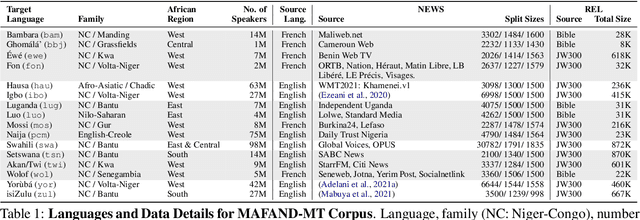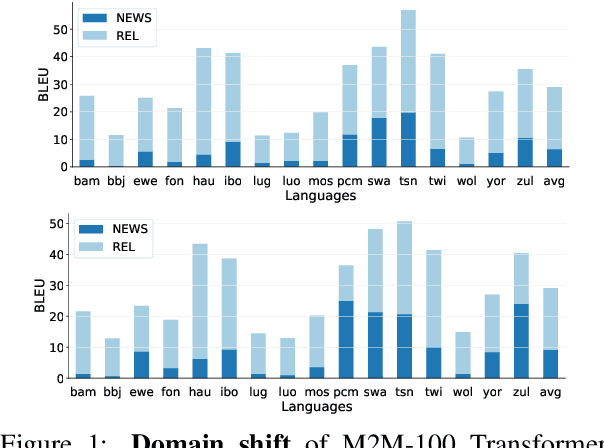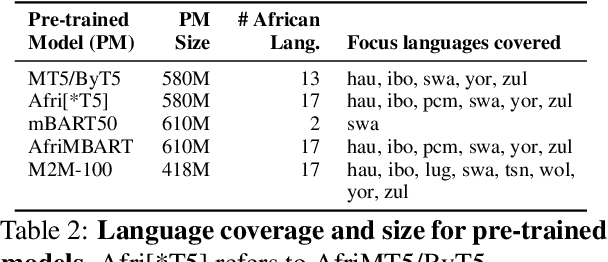Valencia Wagner
PuoBERTa: Training and evaluation of a curated language model for Setswana
Oct 24, 2023Abstract:Natural language processing (NLP) has made significant progress for well-resourced languages such as English but lagged behind for low-resource languages like Setswana. This paper addresses this gap by presenting PuoBERTa, a customised masked language model trained specifically for Setswana. We cover how we collected, curated, and prepared diverse monolingual texts to generate a high-quality corpus for PuoBERTa's training. Building upon previous efforts in creating monolingual resources for Setswana, we evaluated PuoBERTa across several NLP tasks, including part-of-speech (POS) tagging, named entity recognition (NER), and news categorisation. Additionally, we introduced a new Setswana news categorisation dataset and provided the initial benchmarks using PuoBERTa. Our work demonstrates the efficacy of PuoBERTa in fostering NLP capabilities for understudied languages like Setswana and paves the way for future research directions.
A Few Thousand Translations Go a Long Way! Leveraging Pre-trained Models for African News Translation
May 04, 2022



Abstract:Recent advances in the pre-training of language models leverage large-scale datasets to create multilingual models. However, low-resource languages are mostly left out in these datasets. This is primarily because many widely spoken languages are not well represented on the web and therefore excluded from the large-scale crawls used to create datasets. Furthermore, downstream users of these models are restricted to the selection of languages originally chosen for pre-training. This work investigates how to optimally leverage existing pre-trained models to create low-resource translation systems for 16 African languages. We focus on two questions: 1) How can pre-trained models be used for languages not included in the initial pre-training? and 2) How can the resulting translation models effectively transfer to new domains? To answer these questions, we create a new African news corpus covering 16 languages, of which eight languages are not part of any existing evaluation dataset. We demonstrate that the most effective strategy for transferring both to additional languages and to additional domains is to fine-tune large pre-trained models on small quantities of high-quality translation data.
Training Cross-Lingual embeddings for Setswana and Sepedi
Nov 11, 2021Abstract:African languages still lag in the advances of Natural Language Processing techniques, one reason being the lack of representative data, having a technique that can transfer information between languages can help mitigate against the lack of data problem. This paper trains Setswana and Sepedi monolingual word vectors and uses VecMap to create cross-lingual embeddings for Setswana-Sepedi in order to do a cross-lingual transfer. Word embeddings are word vectors that represent words as continuous floating numbers where semantically similar words are mapped to nearby points in n-dimensional space. The idea of word embeddings is based on the distribution hypothesis that states, semantically similar words are distributed in similar contexts (Harris, 1954). Cross-lingual embeddings leverages monolingual embeddings by learning a shared vector space for two separately trained monolingual vectors such that words with similar meaning are represented by similar vectors. In this paper, we investigate cross-lingual embeddings for Setswana-Sepedi monolingual word vector. We use the unsupervised cross lingual embeddings in VecMap to train the Setswana-Sepedi cross-language word embeddings. We evaluate the quality of the Setswana-Sepedi cross-lingual word representation using a semantic evaluation task. For the semantic similarity task, we translated the WordSim and SimLex tasks into Setswana and Sepedi. We release this dataset as part of this work for other researchers. We evaluate the intrinsic quality of the embeddings to determine if there is improvement in the semantic representation of the word embeddings.
 Add to Chrome
Add to Chrome Add to Firefox
Add to Firefox Add to Edge
Add to Edge